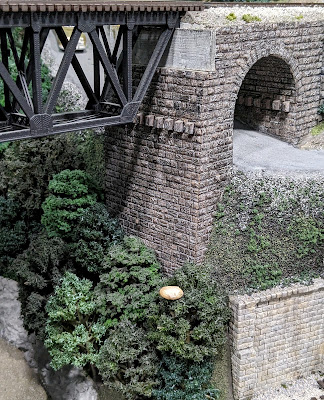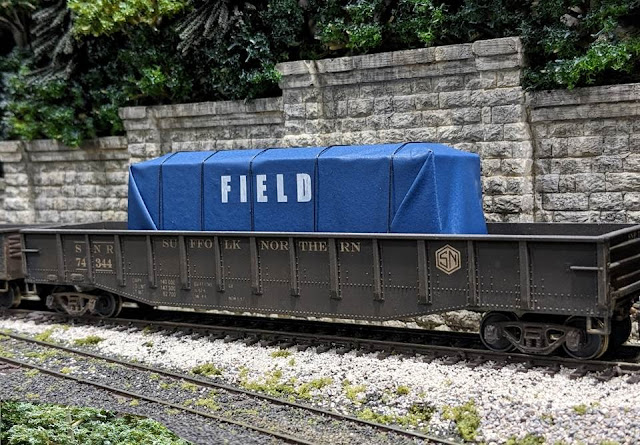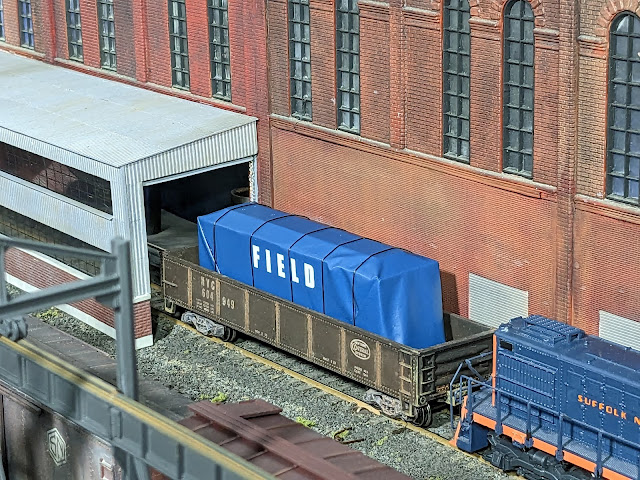I finally had a chance to wrap up the forestry at Mineshaft Gap. I got Virginia Hill (the big ridge) mostly done several years ago, and even "completed" the creek in 2020. But despite the promise of prefab trees, the foreground areas just take forever. For starters there's the me-like stewing over every single tree, in terms of size/shape/color/quality/placement, rather than just carpeting the hillside, as with more distant scenes.
But also, I like to detail the forest floor up front, since you'd be viewing from the middle of the woods in that location. That takes time but it's worth it.
Aside from being able to hide a bunch of "easter eggs" in the woods, catching a glimpse of a passing train through the scrub growth is totally just like life. Railfanning in the eastern US is primarily about getting to where you can see at least one entire piece of rolling stock -- around, over, or through the trees -- before it gets away. Especially in West Virginia.
[Utah? Pffththtt -- "Look Ma, I can see for a hundred miles! I can catch 19 trains in one shot!" Where's the sport in that? Come to hardwood country, fan-boy. 😉]
.
Anyway, first how about a couple of "Before" views, for comparison.


Only the future forest floor is roughed in, beyond the clay cuts and cinder fill. The contour along the creek (far left) is just in plain paint, since the ground will not be visible.
(And how about that shrinkage/separation from the fascia? Fixing that was included as well.)
I'm pleased with the macro result of the "After" -- not just to be relieved of the eyesore of empty contours, but also because it provides a nice defining edge to the scene at Mineshaft Gap, as I'd hoped.
It's a useful viewblock from the areas across the aisle -- makes it feel much less like you're floating in space, and more like you're in a holler watching a railroad bounce off the valley walls. Most of what you can see beyond the hills and woods now is more hills and woods. And backdrop, which of course is even more hills and woods. Starting to feel downright rural.
The new "old growth" on the right-hand side of Logan's Run now highlights the original contour of the valley, vs. the more angular, barren fills put in by the railroad and the pulpwood lot.
SNR's re-alignment of the creek for the overpass
has had a deleterious effect on the opposite valley wall.
Having the forest run down to the roundhouse now helps complete the original vision for the mainline up on the grade, which is of a fill cutting across the valley.
The woods as scene definition and viewblock works in the other direction, too.
Still to come: I need to "organic up" the clay cuts (background) with scrub growth and detritus - but that'll be in the "detailing" portion of our show, later in the program. Like say, in the 2030's.
Several years ago my friend John Miller (Kanawha & Lake Erie) gave me a still he thought belonged nicely in the Appalachian territory transited by the Suffolk Northern. The edge of Mineshaft Gap was about the only wooded place on the layout with a gentle enough grade to use it, so I'd been looking forward to giving it a home for quite a while. Thanks, John!
Sawyer MacShay, whose name in the mountaineer brogue
is pronounced roughly "Sour Mash",
is widely renown for distilling Carter County's finest white lightning,
in the ancient Highland Scot tradition.
I augered out the fire pit so I could use a "Flickering Flame" from Evan Designs.
It's even got its own on/off switch.
The logging road now feels much more like a raw cut through the woods too, as it's supposed to be.
The scrub growth has already filled in the gaps -- but then, it does that.
With visibility at the crossing now inconveniently obstructed by trees,
Ronnet-Pulaski Lumber Co's ramshackle trucks
now have to grind to a responsible halt on the steep,
rutted grade down to the SNR right-of-way.
Well, thanks for reading. Having something to write about is a definite incentive to get stuff done!
And now it's on to the next eyesore. So much barren hillside yet to go... As Robert Frost said,
The woods are lovely, dark and deep,
But I have promises to keep,
And miles to go before I sleep,
And miles to go before I sleep.
But hey, making progress. If you're curious about place names or the oddball trees, see below ***. And let me know what you think down in the comments!
*** Reference links:












































.jpg)












